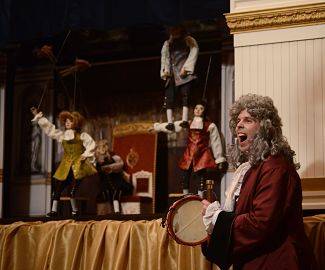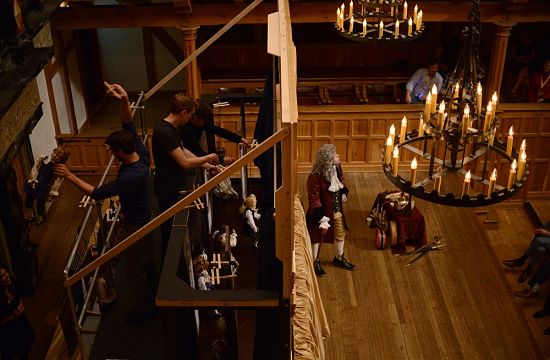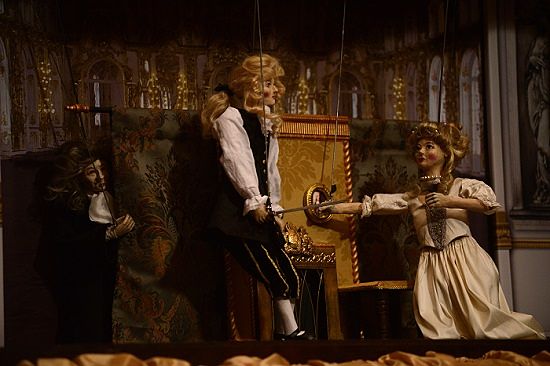Der Bestrafte Brudermord, or Hamlet, Prince of Denmark
by David Glen Robinson
This is the puppet show version of Shakespeare’s Hamlet, Prince of Denmark. Never heard of it? That’s quite understandable, because its very existence was pieced together by rarefied world-class literary research by Oxford professor Tiffany Stern. The initial clue to its existence was a sketchy scenario found in a German monastery in 1710 and published in 1780 as Der Bestrafte Brudermord, translated as The Punished Fratricide. The characters and plot are almost all from Hamlet. Stern’s research sought to answer very large questions: What if this stageplay and script were for a puppet show of Hamlet? Might it have toured Europe in the 17th and 18th centuries? That was the beginning of the excitement.
Professor Stern gave a very lively presentation of the substance of her research in the Thomas Cranfill Endowed Lecture at the University of Texas at Austin on January 16, 2014. She first informed the audience about period theatrical sociology. In those times itinerant acting troupes toured many countries, making their living by entertaining and selling tickets. One of their challenges was satisfying crowds that didn't speak the troupe’s language. The language barrier prompted every traveling troupe to improve skills of visual storytelling, especially of well-known stories, of which Hamlet was one.
 Troupes also dealt necessarily with loss of company members to sickness, death, marriage to locals, and just plain artistic differences. Stern's hypothesis: a way to keep companies together and continue selling tickets for performances of the repertory was to build a few puppets that could be dressed in roles vacated by living actors. Thus the shows eventually featured both live actors and puppets. Narrators, termed translators, voiced the puppets. Translators stood in front of the stage with long sticks with which they pointed out the puppet character in whose voice the translator was speaking at the moment. In this slow evolutionary process, puppet shows with full casts of puppets save for their translators and manipulators began to tour the countryside. Dr. Stern illustrated her talk with period engravings and woodcuts of puppet shows in progress, always with the translators out front, sticks in hand. Most tellingly, Dr. Stern showed photographs of an Italian puppet named Ambleto, Italian for Hamlet, now in a puppet museum in Italy. The puppet has long blond locks and a princely costume. His puppet can carry and manipulate a second puppet or appurtenance, a crudely fashioned human skull puppet.
Troupes also dealt necessarily with loss of company members to sickness, death, marriage to locals, and just plain artistic differences. Stern's hypothesis: a way to keep companies together and continue selling tickets for performances of the repertory was to build a few puppets that could be dressed in roles vacated by living actors. Thus the shows eventually featured both live actors and puppets. Narrators, termed translators, voiced the puppets. Translators stood in front of the stage with long sticks with which they pointed out the puppet character in whose voice the translator was speaking at the moment. In this slow evolutionary process, puppet shows with full casts of puppets save for their translators and manipulators began to tour the countryside. Dr. Stern illustrated her talk with period engravings and woodcuts of puppet shows in progress, always with the translators out front, sticks in hand. Most tellingly, Dr. Stern showed photographs of an Italian puppet named Ambleto, Italian for Hamlet, now in a puppet museum in Italy. The puppet has long blond locks and a princely costume. His puppet can carry and manipulate a second puppet or appurtenance, a crudely fashioned human skull puppet.
Yorick, of course.
Dr. Stern and The Hidden Room’s Beth Burns discovered each other in England while working on various projects. Operating on the basis of What If?, the Hidden Room company took on the full blown project of a stage realization of Der Befstrafte Brudermord, even though the group had done little or nothing with puppetry before. The company used a new English translation of the play by Christine Schmidle and puppets designed by Jesse Kingsley and Moira MacDonald of Mystery Bird Puppet Theatre. When the limits of inference and documentation were exceeded, they relied on 18th century contextualization: How was this done in the 1700s? What did puppet stages look like? What was set design like at the time?
The finished project is a work of impressively complex collaboration.
Revivals of old forms and recombinations of concepts and materials are the stuff of the new. The results here push the envelope of originality. If it wasn’t like this in the 18th century, well, it should have been. The 21st century certainly gains by Hidden Room’s Der Bestrafte Brudermord. The dexterous puppeteers were Joseph Garlock, Ryan Hamilton, Jeff Mills and Kim Adams. Judd Farris and Jason Newman stood out front as translators. In addition to their skilled character voice work, the translators played music, danced, performed all the sound effects, and led the audience in rhythmic clapping while puppets danced. A special shout-out goes to Jennifer Rose Davis, whose contributions crosscut five design fields, with emphasis on authentic recreations of 18th century puppet costumes. Plus, she was the musician for the performance.

In addition to its artistic presentation of a work of world literature, the production kept entertainment value on the front burner, just as 18th century audiences would have demanded. Dr. Stern pointed out in her lecture how at various times both scholars and audiences have shifted their estimate of Hamlet from comedy to tragedy and back again. The Brudermord script makes it a comedy for the most part, with entertaining bloody murders, a la mode in the 18th century. Puppetry endowed the stone-faced puppets with oddly beautiful feeling. The script and play faithfully portray the scene where Hamlet refrains from killing the King Claudius the fratricide as he kneels in prayer of confession and begs for expiation of his mortal sins. The ambivalent Hamlet suffers his crisis of soul. Eighteenth century audiences embraced this scene.
Hamlet’s more than existential visit with Yorick’s skull in the graveyard (Act V, Scene I) is curiously missing from the play.
The short on all of this is that the puppet Hamlet of The Hidden Room perpetuates all of the fascination audiences have felt for it for centuries.

Unanswered questions remain. The Ambleto puppet in Italy, dated narrowly to ca. 1660, carries its Yorick skull attachment, yet Der Bestrafte Brudermord does not feature the graveyard scene. If the Ambleto puppet was used in full-production puppet shows, does this not imply that other puppet Hamlet plays with their differing script versions may have been in production in the 17th and 18th centuries? And if so, might those scripts still be in existence? The scholarly Hamlet mysteries may continue, delightfully so.
For the moment, one can only hope that The Hidden Room’s Der Bestrafte Brudermord tours widely to the benefit of its fans on at least three continents. Anyone with any curiosity about Shakespeare or puppet shows should buy a ticket to this production.
Der Bestrafte Brudermord
by Anonymous after William Shakespeare, translated by Christine Schmidle
Hidden Room Theatre
January 17 - February 08, 2014
Fridays and Saturdays at 8 p.m., Sundays at 5 p.m.
Running time: 75 minutes
All tickets are pick your price $15-$30, with a suggested ticket of $20
Look for a mysterious figure outside the front door. The password is "Horatio."